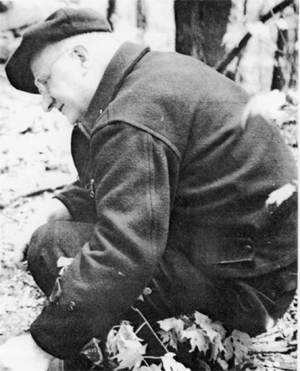
Fr. Philotheus Boehner, O.F.M. (1901-1955)

Philotheus Boehner was born on February 17, 1901 in the village of Lichtenau, Westphalia, Germany. He entered the Franciscan order in 1920, joining the province of the Holy Cross in Saxonia. He studied at the University of Munster in 1929 to 1933 and received his doctorate in biology.
He began his research on the thermonasts of the tulip. His studies on the tulip were published in the Zeitschrift der Botanik under the title "Uber die Thermonastischen Blutenbewegongen bei der Tulpe". He also collected mosses and liverworts known throughout his country. He loved all the creatures of the fields, just like St. Francis of Assisi. From 1933 to 1939 he was a professor of philosophy at a Franciscan school in his province. Fr. Boehner was such a student of Dr. Etienne Gibson's works that in 1939 he was invited by Dr. Gibson himself to lecture to classes in Canada.
Because of the outbreak of World War II, Fr. Boehner was advised to leave the country, and he traveled to the United States. Rev. Thomas Plassmann, O.F.M, the president of St. Bonaventure, invited him to lecture at the school, and Boehner accepted. The following summer, the Franciscan Institute was founded at St. Bonaventure, and Fr. Boehner was named Director. Scholars under Boehner's supervision published work on philosophy, theology, history, and missiology.
Even though Fr. Boehner had such varied success, he never lost his love for biology. He became a part of the biology department at St. Bonaventure as a bryologist. He began a collection of mosses and liverworts of the Cattaraugus County area. His first findings were published in Science Studies under the title "The Sphagna of Cattaraugus County, New York" in 1941. Another article of his appears in the same Science Studies edition entitled "A Check List of the Hepatics of Cattaraugus County, New York - A Preliminary Survey of the County". Science Studies (vol. 9.3-4) included parts one and two of his further findings on local moss. in 1942 he attempted to find interest in his doctoral research by publishing the article On the Thermonasty of the Crocus Flower. In 1943 he published a list of 83 different species of Hepaticae that he found in the Cattaraugus County. In 1949, a bit of information acknowledging the scientific works of Father Philotheus was found in R.M. Schuster's article Ecology and Distribution of Hepaticae in Central and Western New York.
Fr. Boehner will be remembered for his enthusiasm towards his love of nature.

Fr. Boehner hard at work on his studies
![]()
Website created by Greg Shugrue
Spring 2008 Archives Internship (History 495)
Updated & edited by Ellen Winger, Summer 2010.
Last update:12 December 2011